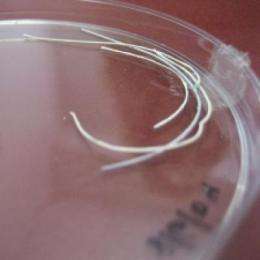A second skin

Despite advances in treatment regimens and the best efforts of nurses and doctors, about 70% of all people with severe burns die from related infections. But a revolutionary new wound dressing developed at Tel Aviv University could cut that number dramatically.
Prof. Meital Zilberman of TAU's Department of Biomedical Engineering has developed a new wound dressing based on fibers she engineered -- fibers that can be loaded with drugs like antibiotics to speed up the healing process, and then dissolve when they've done their job. A study published in the Journal of Biomedical Materials Research - Applied Biomaterials demonstrates that, after only two days, this dressing can eradicate infection-causing bacteria.
The new dressing protects the wound until it is no longer needed, after which it melts away. "We've developed the first wound dressing that both releases antibiotic drugs and biodegrades in a controlled manner," says Prof. Zilberman. "It solves current mechanical and physical limitations in wound-dressing techniques and gives physicians a new and more effective platform for treating burns and bedsores."
Not as simple as it sounds
While the concept is simple, the technology is not. Skin, Prof. Zilberman explains, serves a number of vastly different purposes. "Wound dressings must maintain a certain level of moisture while acting as a shield," she says. "Like skin, they must also enable fluids from the wound to leave the infected tissue at a certain rate. It can't be too fast or too slow. If too fast, the wound will dry out and it won't heal properly. If too slow, there's a real risk of increased contamination."
Prof. Zilberman's new wound dressing, which does not yet have a formal name, is designed to mimic skin and the way it protects the body. It combines positive mechanical and physical properties with what medical researchers call "a desired release profile of antibiotics."
Slashing mortality statistics
Unlike oral antibiotics, locally-applied antibiotics can target and kill harmful bacteria before they enter the body to cause further infection, sepsis, or death. "People who suffer from large burns don't usually die from the condition itself. The fatal culprits are the secondary bacterial infections that invade the body through these vulnerable burned areas," says Prof. Zilberman.
The new TAU dressing inhibits bacterial growth and is biodegradable, which helps doctors avoid constant wound cleaning and redressing, allowing the body to do the work on its own. "When administered at the wound, a doctor can give relatively high but local doses of antibiotics, avoiding any toxicity issues that arise when the same amount of antibiotic passes through the body," explains Prof. Zilberman, who worked on this research with Jonathan Elsner, her PhD student.
Prof. Zilberman is now starting the early stages of clinical trials on animal models. So far, her wound dressing has passed physical and mechanical tests in vitro and in bacterial inhibition tests in the laboratory. She is also seeking a strategic partner to co-develop the research and take it to the commercial stage.
Source: Tel Aviv University (news : web)

















